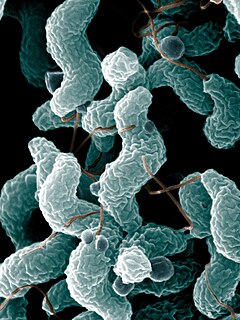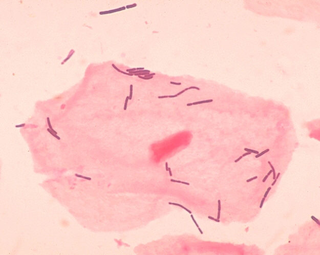Related Research Articles

Bacillus coagulans is a lactic acid-forming bacterial species. The organism was first isolated and described as Bacillus coagulans in 1915 by B.W. Hammer at the Iowa Agricultural Experiment Station as a cause of an outbreak of coagulation in evaporated milk packed by an Iowa condensary. Separately isolated in 1935 and described as Lactobacillus sporogenes in the fifth edition of Bergey's Manual, it exhibits characteristics typical of both genera Lactobacillus and Bacillus; its taxonomic position between the families Lactobacillaceae and Bacillaceae was often debated. However, in the seventh edition of Bergey's, it was finally transferred to the genus Bacillus. DNA-based technology was used in distinguishing between the two genera of bacteria which are morphologically similar and possess similar physiological and biochemical characteristics.
Lacticaseibacillus rhamnosus is a bacterium that originally was considered to be a subspecies of L. casei, but genetic research found it to be a separate species in the L. casei clade, which also includes L. paracasei and L. zeae. It is a short Gram-positive homofermentative facultative anaerobic non-spore-forming rod that often appears in chains. Some strains of L. rhamnosus bacteria are being used as probiotics, and are particularly useful in treating infections of the female urogenital tract, most particularly very difficult to treat cases of bacterial vaginosis. The species Lacticaseibacillus rhamnosus and Limosilactobacillus reuteri are commonly found in the healthy female genito-urinary tract and are helpful to regain control of dysbiotic bacterial overgrowth during an active infection. L. rhamnosus sometimes is used in dairy products such as fermented milk and as non-starter-lactic acid bacterium (NSLAB) in long-ripened cheese. While frequently considered a beneficial organism, L. rhamnosus may not be as beneficial to certain subsets of the population; in rare circumstances, especially those primarily involving weakened immune system or infants, it may cause endocarditis. Despite the rare infections caused by L. rhamnosus, the species is included in the list of bacterial species with qualified presumed safety (QPS) status of the European Food Safety Agency.

Epsilonproteobacteria are a class of Proteobacteria. All species of this class are, like all Proteobacteria, Gram-negative.

The Lactobacillaceae are a family of lactic acid bacteria. It is the only family in the Lactic acid bacteria which includes homofermentative and heterofermentative organisms; in the Lactobacillaceae, the pathway used for hexose fermentation is a genus-specific trait. Lactobacillaceae include the homofermentative lactobacilli Lactobacillus, Holzapfelia, Amylolactobacillus, Bombilactobacillus, Companilactobacillus, Lapidilactobacillus, Agrilactobacillus, Schleiferilactobacillus, Loigolactobacillus, Lacticaseibacillus, Latilactobacillus, Dellaglioa, Liquorilactobacillus, Ligilactobacillus, and Lactiplantibacillus; the heterofermentative lactobacilli Furfurilactobacillus, Paucilactobacillus, Limosilactobacillus, Fructilactobacillus, Acetilactobacillus, Apilactobacillus, Levilactobacillus, Secundilactobacillus, and Lentilactobacillus, which were previously classified in the genus Lactobacillus; and the heterofermentative genera Convivina, Frucctobacillus, Leuconostoc, Oenococcus, and Weissella which were previously classified in the Leuconostocaceae.
Companilactobacillus kimchii is a bacteriocin-producing lactic acid bacterium of the genus Companilactobacillus. It is named for and found in the Korean fermented-vegetable food kimchi.
Lactiplantibacillus paraplantarum is a rod-shaped species of lactic acid bacteria first isolated from beer and human faeces. It is facultatively heterofermentative. Strain CNRZ 1885 is the type strain.
Lactobacillus mucosae is a rod shaped species of lactic acid bacteria first isolated from pig intestines. It has mucus-binding activity. The species is an obligate anaerobe, catalase-negative, doesn't form spores and is non-motile. Its type strain is S32T, and has been found to be most closely related to Lactobacillus reuteri.
Lacticaseibacillus paracasei is a gram-positive, facultatively heterofermentative species of lactic acid bacteria that are commonly used in dairy product fermentation and probiotics. L. paracasei is a bacterium that operates by commensalism. It is commonly found in many human habitats such as human intestinal tracts and mouths as well as sewages, silages, and previously mentioned dairy products. The name includes morphology, a rod-shaped bacterium with a width of 2.0 to 4.0μm and length of 0.8 to 1.0μm.
Azoarcus evansii is a species of bacteria. Its type strain is KB 740T.
Ligilactobacillus acidipiscis is a species in the genus Ligilactobacillus. It is a homofermentative, rod-shaped lactic acid bacteria. Its type strain is FS60-1T.
Lactiplantibacillus fabifermentans is a member of the genus Lactiplantibacillus and a type of lactic acid bacteria (LAB), a group of Gram-positive bacteria that produce lactic acid as their major fermented end product and that are often involved in food fermentation. L. fabifermentans was proposed in 2009 as a new species, after the type strain LMG 24284T has been isolated from Ghanaian cocoa fermentation. Analysis of the 16S rRNA gene sequence demonstrated that this species is a member of the Lactobacillus plantarum species group but further analysis demonstrated that it is possible to differentiate it from the nearest neighbors by means of DNA-DNA hybridization experiments, pheS sequence analysis, whole-cell protein electrophoresis, fluorescent amplified fragment length polymorphism analysis and biochemical characterization.
Lacticaseibacillus manihotivorans is a starch-hydrolysing lactic acid bacterium first isolated during Cassava sour starch fermentation. It is Gram-positive, catalase-negative, non-spore-forming, non-motile rod-shaped and homofermentative, with type strain OND 32T.
Lactobacillus kefiranofaciens is a species of slime-forming, homofermentative, rod-shaped lactic acid bacteria first isolated from kefir grains, hence its name. Its type strain is WT-2B. Its genome has been sequenced.
Weissella bombi is a bacterium from the genus of Weissella which has been isolated from the gut of the bumblebee Bombus terrestris from Ghent in Belgium.
Olsenella profusa is a bacterium from the genus of Olsenella which has been isolated from subgingival plaque in the United States.
Lactobacillus porci is a species of bacteria that falls within the Lactobacillus genus. Species within this genus are typically facultative anaerobes, gram-positive rods, non-spore forming, and are able to produce lactic acid from fermentation of glucose. The species of bacteria is located primarily in guts of mammals and insects.
Apilactobacillus is a genus of bacteria from the family of Lactobacillaceae.
References
- 1 2 3 "Species: Apilactobacillus apinorum". lpsn.dsmz.de.
- ↑ "Lactobacillus apinorum". www.uniprot.org.
- ↑ Olofsson, Tobias C.; Alsterfjord, Magnus; Nilson, Bo; Butler, Èile; Vásquez, Alejandra (1 September 2014). "Lactobacillus apinorum sp. nov., Lactobacillus mellifer sp. nov., Lactobacillus mellis sp. nov., Lactobacillus melliventris sp. nov., Lactobacillus kimbladii sp. nov., Lactobacillus helsingborgensis sp. nov. and Lactobacillus kullabergensis sp. nov., isolated from the honey stomach of the honeybee Apis mellifera". International Journal of Systematic and Evolutionary Microbiology. 64 (Pt_9): 3109–3119. doi: 10.1099/ijs.0.059600-0 .